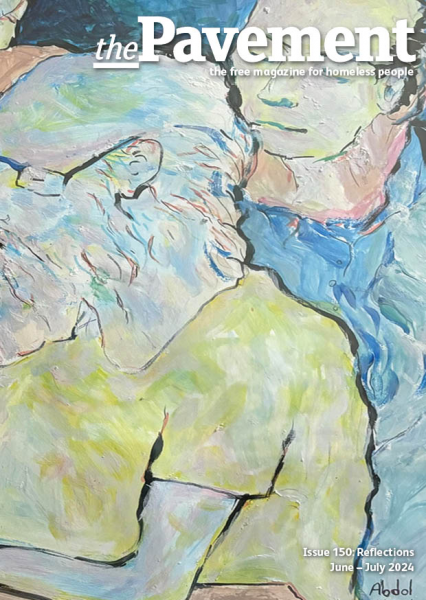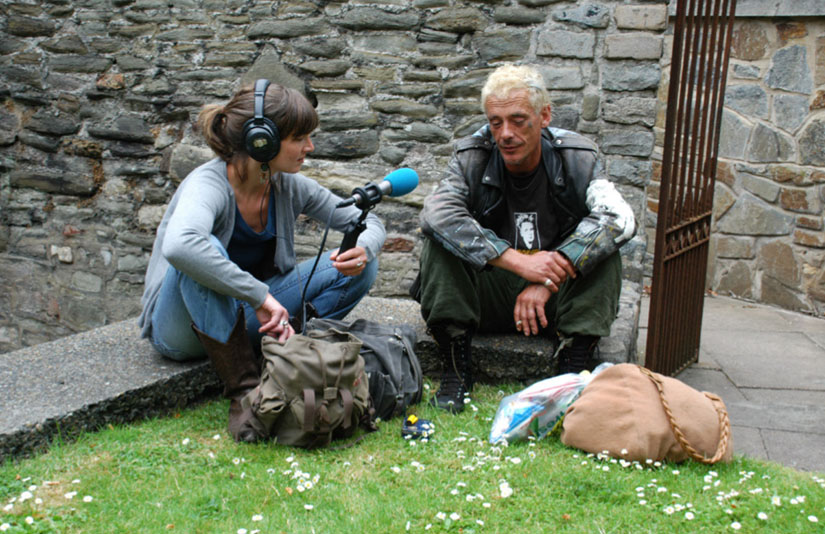
Established 2005 Registered Charity No. 1110656
Scottish Charity Register No. SC043760
DONATE
RECENT TWEETS
What would you say if Oxford University researcher Rachael Kiddey asked you to try some archaeology techniques (such as mapping and digging) where you rough sleep?
The Homeless Heritage project involved more than 40 homeless people working as archaeologists to create maps of Bristol and York that you won’t find on the tourist trail – abandoned industrial areas, bridge shelters, bin stores and neglected ruins. Homeless people then worked with university students on two archaeological digs.
They uncovered ceramic, glass and items specifically related to homelessness such as phone cards, portable food packaging and materials associated with drinking and drug use.
“Contemporary archaeology is relatively new,” explains Dr Rachael Kiddey. “You apply the same archaeological principles that you’d use on prehistoric, Roman or medieval sites which tell you something about how people lived. But now you can apply these same methods to contemporary cultures, especially those that you might not know so much about. As archaeologists, we’re used to digging up sites of massacres or battlefields, really dark material.
Working with homeless people as colleagues, we were able to interpret what the materials we found on modern day homeless sites were, what they meant, and how they were used. This showed us some new insights into homelessness.”
Homeless Heritage, the book, was published by Oxford University Press in October 2017. “It is the story of how we did this project,” says Kiddey while on maternity leave from the Pitt Rivers Museum in Oxford. Pre-kids she used to squat and set up community spaces in Bristol.
Bristol and York
Over the four-year project, Kiddey explained to the rough sleepers she met that, “I wanted to map and document the city according to you – not Bristol or York city council, or where people like to go shopping. How is each city used by homeless people and which parts do you identify with and why? Tell me your stories. Be my guide. Some said ‘F off’. Some said ‘how can you be an archaeologist if you don’t dig in the ground’? And some said ‘that’s interesting I’ll show you around’. The two latter camps came together. There were about five in the core team and the peripheral project attracted 40–50 people who showed me where they slept, socialised, or why particular places were good to sit (for example, south facing because it’s warmer, or on land where the ownership is dubious).”
“People avoided private steps. They felt they were much better off on council-owned land or spaces that were ambiguous, such as Turbo Island in Bristol. It is the foundations of a bombed out building that became an island when the road was widened. Because it’s not clear who the land is owned by, people don’t get kicked off, so it has become a homeless hub. It’s a place to gather, pass on messages, cadge a cigarette, and have a beer without the police saying you are not allowed to drink. But that’s a catch-22 because homeless people then gather there to use the space, so it becomes known as a homeless place and attracts more attention from the authorities,” added Rachael.
Real experts
Kiddey hopes her collaboration will help organisations working on homelessness. “If you can design a project where homeless people are given genuine opportunities to direct how it is run, and you are willing to listen to their expert knowledge then you can find pockets of shared humanity, things that unite us all as people.
I thought homeless people would be preoccupied by how cold or wet it was, but instead they talked a lot about what they noticed about a place where they slept and might say they ‘wondered what this old building was’. It was bonding. I also learnt things that helped me to better understand rough sleepers. For example homeless people sleep in the day because at night it’s too dangerous and colder.”
“We’re used to thinking of nice castles, country houses and artwork as cultural heritage, but heritage is relationships between people, places and things that mean something to you as a person,” explains Kiddey.
“The power of cultural heritage is that you can explain what your world looks like and you can listen to what someone else’s is like. It’s accessible to everyone, regardless of their background or class, and that’s very empowering.”
With thanks to Andrew, Annie and Jane, and several colleagues who sadly died during Rachael’s project, including Dan, Ray and Punk Paul.
Homeless Heritage: Collaborative Social Archaeology as Therapeutic Practice by Dr Rachael Kiddey (Oxford University Press, 2017)
In a nutshell
For four years 40+ homeless people worked with archaeologists and university students in Bristol and York.
They weren’t looking for old items like on TV’s Time Team.
The digs were to look for items that reveal information about people now.
It’s contemporary archaeology.
The resulting book offers new insights into homelessness.
June – July 2024 : Reflections
CONTENTS
BACK ISSUES
- Issue 150 : June – July 2024 : Reflections
- Issue 149 : April – May 2024 : Compassion
- Issue 148 : February – March 2024 : The little things
- Issue 147 : December 2023 – January 2024 : Next steps
- Issue 146 : October 2023 – November 2023 : Kind acts
- Issue 145 : August 2023 – September 2023 : Mental health
- Issue 144 : June 2023 – July 2023 : Community
- Issue 143 : April 2023 - May 2023 : Hope springs
- Issue 142 : February 2023 - March 2023 : New Beginnings
- Issue 141 : December 2022 - January 2023 : Winter Homeless
- Issue 140 : October - November 2022 : Resolve
- Issue 139 : August - September 2022 : Creativity
- Issue 138 : June - July 2022 : Practical advice
- Issue 137 : April - May 2022 : Connection
- Issue 136 : February - March 2022 : RESPECT
- Issue 135 : Dec 2021 - Jan 2022 : OPPORTUNITY
- Issue 134 : September-October 2021 : Losses and gains
- Issue 133 : July-August 2021 : Know Your Rights
- Issue 132 : May-June 2021 : Access to Healthcare
- Issue 131 : Mar-Apr 2021 : SOLUTIONS
- Issue 130 : Jan-Feb 2021 : CHANGE
- Issue 129 : Nov-Dec 2020 : UNBELIEVABLE
- Issue 128 : Sep-Oct 2020 : COPING
- Issue 127 : Jul-Aug 2020 : HOPE
- Issue 126 : Health & Wellbeing in a Crisis
- Issue 125 : Mar-Apr 2020 : MOVING ON
- Issue 124 : Jan-Feb 2020 : STREET FOOD
- Issue 123 : Nov-Dec 2019 : HOSTELS
- Issue 122 : Sep 2019 : DEATH ON THE STREETS
- Issue 121 : July-Aug 2019 : INVISIBLE YOUTH
- Issue 120 : May-June 2019 : RECOVERY
- Issue 119 : Mar-Apr 2019 : WELLBEING
- Issue 118 : Jan-Feb 2019 : WORKING HOMELESS
- Issue 117 : Nov-Dec 2018 : HER STORY
- Issue 116 : Sept-Oct 2018 : TOILET TALK
- Issue 115 : July-Aug 2018 : HIDDEN HOMELESS
- Issue 114 : May-Jun 2018 : REBUILD YOUR LIFE
- Issue 113 : Mar–Apr 2018 : REMEMBRANCE
- Issue 112 : Jan-Feb 2018
- Issue 111 : Nov-Dec 2017
- Issue 110 : Sept-Oct 2017
- Issue 109 : July-Aug 2017
- Issue 108 : Apr-May 2017
- Issue 107 : Feb-Mar 2017
- Issue 106 : Dec 2016 - Jan 2017
- Issue 105 : Oct-Nov 2016
- Issue 104 : Aug-Sept 2016
- Issue 103 : May-June 2016
- Issue 102 : Mar-Apr 2016
- Issue 101 : Jan-Feb 2016
- Issue 100 : Nov-Dec 2015
- Issue 99 : Sept-Oct 2015
- Issue 98 : July-Aug 2015
- Issue 97 : May-Jun 2015
- Issue 96 : April 2015 [Mini Issue]
- Issue 95 : March 2015
- Issue 94 : February 2015
- Issue 93 : December 2014
- Issue 92 : November 2014
- Issue 91 : October 2014
- Issue 90 : September 2014
- Issue 89 : July 2014
- Issue 88 : June 2014
- Issue 87 : May 2014
- Issue 86 : April 2014
- Issue 85 : March 2014
- Issue 84 : February 2014
- Issue 83 : December 2013
- Issue 82 : November 2013
- Issue 81 : October 2013
- Issue 80 : September 2013
- Issue 79 : June 2013
- Issue 78 : 78
- Issue 77 : 77
- Issue 76 : 76
- Issue 75 : 75
- Issue 74 : 74
- Issue 73 : 73
- Issue 72 : 72
- Issue 71 : 71
- Issue 70 : 70
- Issue 69 : 69
- Issue 68 : 68
- Issue 67 : 67
- Issue 66 : 66
- Issue 65 : 65
- Issue 64 : 64
- Issue 63 : 63
- Issue 62 : 62
- Issue 61 : 61
- Issue 60 : 60
- Issue 59 : 59
- Issue 58 : 58
- Issue 57 : 57
- Issue 56 : 56
- Issue 56 : 56
- Issue 55 : 55
- Issue 54 : 54
- Issue 53 : 53
- Issue 52 : 52
- Issue 51 : 51
- Issue 50 : 50
- Issue 49 : 49
- Issue 48 : 48
- Issue 47 : 47
- Issue 46 : 46
- Issue 45 : 45
- Issue 44 : 44
- Issue 43 : 43
- Issue 42 : 42
- Issue 5 : 05
- Issue 4 : 04
- Issue 2 : 02
- Issue 1 : 01
- Issue 41 : 41
- Issue 40 : 40
- Issue 39 : 39
- Issue 38 : 38
- Issue 37 : 37
- Issue 36 : 36
- Issue 35 : 35
- Issue 34 : 34
- Issue 33 : 33
- Issue 10 : 10
- Issue 9 : 09
- Issue 6 : 06
- Issue 3 : 03
- Issue 32 : 32
- Issue 31 : 31
- Issue 30 : 30
- Issue 29 : 29
- Issue 11 : 11
- Issue 12 : 12
- Issue 13 : 13
- Issue 14 : 14
- Issue 15 : 15
- Issue 16 : 16
- Issue 17 : 17
- Issue 18 : 18
- Issue 19 : 19
- Issue 20 : 20
- Issue 21 : 21
- Issue 22 : 22
- Issue 23 : 23
- Issue 24 : 24
- Issue 25 : 25
- Issue 8 : 08
- Issue 7 : 07
- Issue 26 : 26
- Issue 27 : 27
- Issue 28 : 28
- Issue 1 : 01

